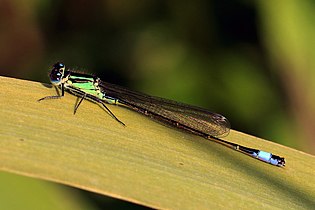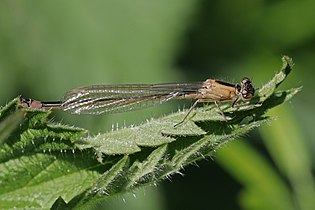Blue-tailed damselfly
| Blue-tailed damselfly | |
|---|---|

| |
| Mature male | |

| |
| Female, form rufescens | |
| Scientific classification | |
| Domain: | Eukaryota |
| Kingdom: | Animalia |
| Phylum: | Arthropoda |
| Class: | Insecta |
| Order: | Odonata |
| Suborder: | Zygoptera |
| Family: | Coenagrionidae |
| Genus: | Ischnura |
| Species: | I. elegans
|
| Binomial name | |
| Ischnura elegans (Vander Linden, 1820)
| |
| Synonyms | |
| |
The blue-tailed damselfly or common bluetail (Ischnura elegans) is a damselfly, belonging to the family Coenagrionidae.[1]
Subspecies and varieties
Subspecies and varieties include:[2]
- Ischnura elegans ebneri Schmidt, 1938
- Ischnura elegans elegans (Vander Linden, 1820)
- Ischnura elegans pontica Schmidt, 1939
- Ischnura elegans f. infuscans
- Ischnura elegans f. infuscans-obsoleta
- Ischnura elegans f. rufescens
- Ischnura elegans f. typica
- Ischnura elegans f. violacea
Distribution
This species is present in most of Europe[3] and the middle-east. It is a common species.
Habitat
These damselflies can be found in a wide range of lowland environments, with standing and slow flowing waters, brackish and polluted water.[4]
Description

Ischnura elegans can reach a body length of 27–35 millimetres (1.1–1.4 in) and a wingspan of about 35 millimetres (1.4 in). Hindwings reach alength of 14–20 millimetres (0.55–0.79 in).[5] Adult male blue-tailed damselflies have a head and thorax patterned with blue and black. There is a bi-coloured pterostigma on the front wings. Eyes are blue.[4] They have a largely black abdomen with very narrow pale markings where each segment joins the next. Segment eight, however, is entirely pale blue.[4] At rest, the wings of most damselfly species are held back together, unlike dragonflies, which rest with their wings out flat. The thorax of juvenile males has a green tinge.[5]
Female blue-tailed Damselflies come in a variety of colour forms.[4] Juveniles may be salmon pink, form rufescens; violet, form violacea and a pale green form. The colour darkens as the damselfly ages. Mature females may be blue like the male, form typica; olive green thorax and brown spot, form infuscans or pale brown thorax and brown spot, form infusca-obseleta.[5][4]
Biology and behavior
Adults fly from April to September to early October.[4] The adult damselflies prey on small flying insects, caught using their legs like a basket to scoop the prey up while flying, or insects taken from leaves. Damselfly nymphs are aquatic, and prey on small aquatic insects or other aquatic larvae.
A male can try to interfere with a mating pair, by attaching itself to the mating male. The females always lay their eggs on the floating parts of the plants without any involvement of the male.
Blue-tailed Damselflies are superb fliers and can alter each of their four wing's kinematics in order to maneuver. A recent study has shown that they can compensate for a whole wing loss and even successfully maneuver and catch prey.[6]
Gallery
-
Mating, female f. typica
-
nymph
-
emerging
-
Immature male
-
teneral female form rufescens
-
Female form rufescens
-
Female form violacea
-
Female form rufescens-obsoleta
References
- ^ Bisby F.A., Roskov Y.R., Orrell T.M., Nicolson D., Paglinawan L.E., Bailly N., Kirk P.M., Bourgoin T., Baillargeon G., Ouvrard D. Catalogue of life
- ^ Biolib
- ^ Fauna europaea
- ^ a b c d e f BDS - British Dragonfly Society
- ^ a b c L. Watson and M. J. Dallwitz British Insects: the Odonata (Dragonflies and Damselflies
- ^ Kassner, Ziv; Dafni, Eyal; Ribak, Gal (2016-02-01). "Kinematic compensation for wing loss in flying damselflies". Journal of Insect Physiology. 85: 1–9. doi:10.1016/j.jinsphys.2015.11.009. PMID 26598807.
External links
 Media related to Ischnura elegans at Wikimedia Commons
Media related to Ischnura elegans at Wikimedia Commons Data related to Ischnura elegans at Wikispecies
Data related to Ischnura elegans at Wikispecies








